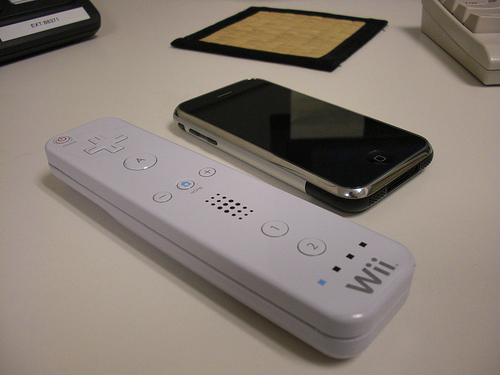A crash came ringing down from the play room, one that clearly didn’t sound good. “What was that?” I shout up to my son. “I broke the Wii, Dad” was his response. You broke the Wii? I hop upstairs only to find a fresh, menacing spider web crack on the 47 inch flat screen TV. “Um, no son” I said, “You broke the TV.”
The next question asked was rhetorical. “How did this happen?” “I threw the remote” he said. And the next, only slightly less rhetorical question to follow was “Why?” My son shrugged his shoulders. “Did you get that mad playing Mario Brothers?”
Nodding. “Did you not make it to the end of a level?” Nodding. “Did you really throw the remote?” I felt the need to confirm. “Yes. Are you mad at me Dad?” I paused. ”No son, I’m not really happy right now, but I’m not mad at you, I’m mad at me…”
My son has inherited the Have-To-Succeed (HTS) gene from me. For whatever reason, I was unable to find any one of the hundreds of articles and studies to support the existence of HTS, but I’m telling you it’s real and he’s got it. It’s hard for those who don’t have HTS to understand. On its surface, it sounds desirable to have. And for the most part, the gene is an agent of good, serving as a powerful motivating force to drive one to achieve. But it can quickly turn bad when confronted by its nemesis: Frustration.
Frustration is a common emotional response to opposition and arises from the perceived resistance to the fulfillment of individual will. Oversimplifying, if you don’t really care about the obstruction and the need to overcome it, then you don’t allow yourself to get frustrated. And not caring is a lot easier said than done for those without HTS.
Truth be told, there is likely not one friend who’s ever spent much time with me over the past 30 years who can’t recall some situation where I’ve kicked, screamed, pouted, cursed or thrown something somewhere. I’ve played in my share of sports, competitions, and yes, video games. These are all likely battlegrounds of obstruction and will. But the difference with my son is the fact that he lives in the Digital Device society of tablets, phones, hand-held game consoles, laptops, and Wiis where there is ample opportunity for exposure to games and to put HTS to the test.
But is Digital Land really to blame? I started to think back, oh so long ago when he was three. I recall this same child, who if he colored outside the lines, would throw the crayon and want to rip up the sheet, only to start over on a new picture and color flawlessly. The same child who would angrily walk away from the floor puzzle because he could not find the one piece of twenty-four he was looking for to fill a very particular spot, only to return three minutes later to finish. And the same child who would smash his stack of blocks he’d meticulously stacked if one happened to teeter or gently move out of place, only to start construction again and make it better. So no, Mario and Luigi and Princess Peach are simply the current challenge at hand.
And so what to do about Frustration? The simple answer would be to take the Wii away. But that vindication on behalf of the TV would be fleeting. The better answer we’ve found is to fight fire with fire.
Frustration rules the day if my son can’t solve a level of Mario Brothers. This isn’t rocket science, but he does need the information to do so. And ironically, the answer was right at our fingertips, literally. Lately, every time he wants to “have my phone,” it’s to watch a snippet of an 8 hour “How To Solve Mario Bros.” video on YouTube. Yes, they are 8 hours sometimes of a group of kids playing level after level after level. When my son finds a thumbnail he recognizes, he watches, listens, processes, and learns.
Don’t believe me? I’ve subsequently seen my son navigate a level that likely would have taken me 20 hours to solve 20 years ago in a world before the Internet. I don’t know if that’s good or bad, but it’s reality when the world’s information is so readily available to anyone as fast as you can type it into Google, or YouTube.
Back to the Crash. Obviously, my son didn’t watch enough video to prep for that day, and the TV took the brunt. But now when we play, I’ve started to ask him “What did those boys do in the YouTube video?” And if we need to stop and look it up, we do. And when he really gets frustrated, I remind him that in the video, the kids don’t yell and scream and get mad when their character runs out of lives, they laugh. And when it’s apparent he’s simply had too much, I encourage him to walk away from Frustration, take a break, get his head clear, and come back with better focus and attitude later. Having learned that valuable lesson myself, thanks to my HTS, that is the best wisdom I can pass on.
In the continued battle of Dad (and Mom) versus Digital Devices, I don’t think we’re winning the war as it relates to my son. He is just so enamored with all this technology and instant gratification. But we’re learning to channel the power of Digital rather than pulling the plug entirely; the Digital Device onslaught has only just begun. And while I’m grateful for the 8 hour ‘How To’ videos to help my situation, I’m glad it’s not my son spending all the time to make them, at least not yet.
Posted on 3/11/2014
Matthew J Beshear is a Dad. And a husband, too. And along with his wife, they struggle each day to find the balance for their children between an ever evolving world of digital, devices, technology, and instant gratification and breathing fresh air, interacting with other humans, and having conversations with family when going out to dinner.














Leave A Comment
You must be logged in to post a comment.